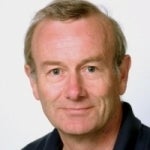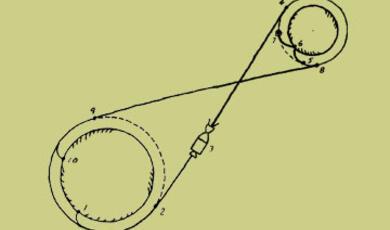The Particle Odyssey: Visions of the subatomic world
Share
- Details
- Transcript
- Audio
- Downloads
- Extra Reading
This talk will show some of the visual beauty revealed by particles - a world remote from our immediate senses but one that is real and visible.
Download Transcript
The Particle Odyssey: Visions of the subatomic world
Professor Frank Close OBE
(The numbers refer to figures in The Particle Odyssey, available from booksellers or via Gresham College at a discount price of £21.95. I hope this talk and set of images whet your appetite; the thousand questions that they raise will, I hope, be answered in the book; in this brief survey I can only give a first glimpse)
0. BOOK COVER 1.21
Why does the devil have all the best tunes? Why does NASA have all the best pictures?
Somewhere in the 1980s I began to get increasingly annoyed at the perception that, in the words of a BBC producer: "you cannot interest people in particles; they're too small to see". A long fight ensued, culminating in my BBC2 Royal Institution Christmas Lectures in 1993, which proved that particles can be made visible and the results are interesting too: there is a strange beauty in the world "beyond (normal) vision". By extending our senses we can reveal it and produce art. And only last month, images of data from the subatomic world won awards at the Daily Telegraph/Novartis competition.
The images of the microworld are so extraordinary, and can bring its characters to life, that in 1988 we produced The Particle Explosion, a collection of classic images from the 20th century. It won awards and a couple of years ago we were asked to produce a follow-up. It was a shock to realize that LEP had not begun when we produced "Explosion"; in "Odyssey", LEP plays a major role. But this is also a storybook, so let's start at the beginning.
1. THEN AND NOW
How things have changed in a hundred years. In 1897 Thomson discovered the electron with a simple piece of apparatus, in his laboratory in Cambridge. Today we recreate the conditions of the Big Bang; you don't buy a piece of suitable apparatus from the science catalogues, you must make them from scratch. It takes teams of hundreds in accelerators that are miles in size. Compare this in the following images (numbers refer to the figures in the book).
cambridge 1.2 (low)
thomson apparatus 1.3 (low)
fermilab 6.1 p.80 (low res)
apparatus evolve p.1 and 1.17 (low res) or 8.1
Thomson discovered the electron, the constituent of all atoms and driver of chemistry biology and life. In a magnetic field an electron will spiral and leave a characteristic trace. We can see this in images taken some ninety years ago in a cloud chamber, fifty years ago in a bubble chamber and a recent image in a modern electronic detector. The autograph is common; the means of producing it has evolved.
electrons: cld chamber 3.5
bub ch spiral 5.1
modern 9.6
The quantum theory tells us that electrons, like all particles, have an enigmatic duality, sometimes acting as particles, other times as waves. We can even see this with modern microscopes. A ring of individual atoms are collected and placed on the surface of a piece of copper. Copper is a conductor and electrons flow freely at its surface. But those trapped inside the atomic ring form standing waves, seen as the set of concentric circles in the image. So here we are seeing atoms and even the quantum wave nature of electrons.
electron waves in copper 2.1 (low res)
The antiworld can be seen in this simple image. The positron is the antiparticle of the electron. Same mass and size, but opposite sign of electric charge cause the positron to spiral in the opposite direction to that of the electron. This image shows this subtle symmetry. It has a raw beauty akin to a primitive cave drawing whereas in fact it is an image from the frontiers of science.
Electron positron "primitive" 5.2
You can almost see the effect of electrons in a plasma ball. As electrons swarm through the gas, they shake light out along their path. It was the discovery of such eerie glows in the 19th century that led to the discovery of X rays, radioactivity, the electron and modern science.
plasma 3.6 gives cue to how it all began:
2. OLD DAYS
Rontgen discovered X-rays and produced one of the most famous images in history. In turn this led to the discovery of radioactivity. Alpha particles are pieces of atomic nuclei (actually the nuclei of helium) that can be ejected spontaneously by some elements. They are emitted with a characteristic specific energy and will travel a finite distance before they are slowed to a halt by collisions with atoms in the material. They will leave trails in photographic emulsion: this shows the powerful radioactivity of a speck of radium.
The first images of alpha trails in a cloud chamber 90 years ago are tenuous; once you know what to look for the ability to reveal things rapidly improves. This is seen in the very clear image of alphas that have shot out in random directions, but always reaching the same distance.
roentgen
visible radioactivity alphas in emulsion 2.9;
first alphas 2.26;
gets nicer = bullets 2.20
It was the fact that alphas travel a common distance that showed that they have a fixed energy. This was a key that Rutherford used in his discovery of the atomic nucleus. He used alphas as bullets; knowing their energies, and measuring their deflection, enabled him to calculate the electrical forces acting on them. This in turn proved that these forces were located in a compact nucleus at the heart of the atom (this was described in my talk last year). They are scattered by small or large angles when they hit heavy or light nuclei. As a football will knock a ping pong ball sharply forward, so an alpha knocks a proton at a shallow angle. And as a ping pong ball will bounce back sharply from a football, so do alphas recoil at large angles from heavy nuclei of iron. Balls of the same mass will bounce apart at right angles; the same is true for protons. So from these images of different atomic nuclei bouncing off one another, one begins to measure the relative masses of the nuclei of different elements.
rutherford notes 2.19
application to scattering 3.9 - 3.11
protons at 90degrees 3.12
3. SCATTERING
electrons knocked out of atoms 3.3, 3.4
e beams slac 6.37;6.41
HERA 8.39; 8.40; 7.22 (e scatter version of 7.23?)
q jets at HERA 9.19; at LEP 9.27; "see them" 7.23
[also see q in UA1 8.21 ISR, 8.26 UA1, 8.27]
Electrons occur in all atoms and are easily ejected. A passing alpha particle knocks out electrons from the atoms of the emulsion (cloud chamber?) - they are the little nodules along the trail of the alpha. A high energy cosmic ray imparts huge momentum to the atomic electrons and knocks one far out, where its path is curved by a magnetic field.
Electrons being electrically charged can be accelerated by electric fields. In the 3 km long linear accelerator at the Stanford Linear Accelerator Center (SLAC), the electrons start off from an electron 'gun' where they are released from a heated filament, at the end of the machine near the bottom of the picture. The electrons in effect surf ride along radio waves set up in a chain of 100 000 cylindrical copper 'cavities', about 12 cm in diameter. The machine is aligned to 0.5 mm along its complete length. By the time they reach the far end of the accelerator, beyond the freeway, the electrons have an energy of 30 GeV, and are ready to be delivered to experiments.
The beam enters through the pipe coming in from the left and collides with the 'target' (surrounded by concrete blocks). The electrons scatter from particles in the target's nuclei through a variety of angles, as if in a game of subatomic billiards; or they may produce other new particles from their high-energy collisions. Three 'spectrometers' record the results. One is the tall grey cylinder behind the target area; the second is the structure incorporating the large yellow 'container', with the third partially hidden behind it. The spectrometers contain banks of different detectors to track the scattered particles, and magnets to measure their momentum. They can be rotated to different positions around the target along the rails that are visible. The scale of these instruments, which provided the first direct evidence for quarks, is given by the man standing at the foot of the yellow 'container'.
(The electrons occasionally bounced violently from the protons in the target, showing that the electric charge of the proton is concentrated on tiny constituents, the quarks; this was analogous to the way that Rutherford had earlier revealed the presence of the atomic nucleus by the violent scattering of alpha particles).
4. COSMICS AND PARTICLES
diagram 4.1
collision 3.7
strange particle vees 5.10; modern 5.11, 10.7
other strange particles 5.13,5.14
use strange beams even more strange 5.16
accels and bub ch scanning 6.26
elegant b c pic 5.3
sparks = electronic b.c. 5.8
really nice modern 10.10? 9.20 found the W
Thousands of metres above the Earth's surface, the outer atmosphere experiences a continuous bombardment. The 'artillery' comes in two forms: photons and subatomic particles. The high-energy rain of particles has become known as cosmic radiation, but in many respects it is quite different from the alpha and beta radiation emitted by radioactive nuclei. Cosmic ray particles have much higher energies than alpha and beta rays, and are thinly spread. At sea level this has been reduced to about one particle per square centimetre per minute. By comparison, a gram of a radioactive substance such as radium emits thousands of millions of particles every second.
Cosmic rays have very high energies, rising to 10 million million times the maximum energy of the radiation from radioactive sources. With these, Nature provided us with the first glimpse of a world beyond our previous experience. When a cosmic ray particle hits an atom, it produces a shower of particles. These included trails that were gradually decoded, like the Rosetta stone, and revealed strange particles that were unknown on Earth.
(It was the desire to replicate the effects of cosmic rays under controlled conditions that led to the era of particle accelerators and the birth of high energy physics).
Fig 5.10 shows the discovery of the first strange particle, recorded in 1946 by Rochester and Butler at Manchester. It was originally known as a V particle, due to the characteristic vee. This image shows a pair of tracks forming a pronounced fork (A) just below the lead plate across the centre of the chamber. This was probably due to a neutral kaon, produced in an interaction in the lead, which decayed into a negative and a positive pion. (What these are and why it's a vee: I'm afraid that I have to refer you to the book).
The "vee", originally seen in 1946 in a cloud chamber, is also common in modern experiments using sophisticated electronic detectors. It's the fingerprint that's important, not how its made.
Once we knew that strange particles exist, the challenge was to make intense beams of them to see what happened when they hit atomic particles. This revealed particles that were even more stranger than those that had shown up in the cosmic rays. It was their discovery that eventually led to the realization that protons, neutrons, the strange particles and other relations are all made of more fundamental particles, the quarks.
Making these particles visible became dramatically possible with the invention of the bubble chamber. When electrically charged particles pass through a liquid under certain critical conditions of temperature and pressure, bubbles develop where the particle passes. The resulting trails show where particles have passed, however transiently. The images have an enigmatic beauty of their own. Thousands of photos were taken and only a handful would have anything "interesting". Finding them was the task of specially trained "scanners".
Fig. 6.26 shows a scanner at work inspecting film from bubble chambers at Brookhaven in 1964. Film was projected onto a table to give a life-size image, which could then be measured.
5. TOO SHORT TO SEE?
electronics can see the gaps 9.14.9.15
idea of dalitz plot explain
9.18 or easier 7.11 and 7.10 shows resonant "spectral lines"
spectrum of light 3.18
this gives idea of substructure and hence quarks.
show slide of standard model
top to bottom 9.34 and 9.35
Extremely short-lived particles are generally known as 'resonances'. Their lifetimes are of the order of 10-23 s. A span of 10-23 s fits into a millionth of a second, as does a millionth of a second into three thousand years! It is no wonder the resonances leave no visible tracks: even at the speed of light they travel barely further than their own diameter.
One way of revealing resonances such as the omega meson is the diagram invented in the early 1950s by Richard Dalitz. The basic idea is this. When a resonance decays its decay products can move off in any direction and with any speed provided the total energy and momentum add up to that of the original resonance. In Dalitz's technique, events are plotted as points on a diagram where the position of each event is determined by the speed of the particles and the directions in which they emerge. Then you look at the resulting 'Dalitz plot' to see if there is a concentration in some region, which is what would happen if a resonance, with some specific mass, had briefly given rise to the particles. The Dalitz plot in Fig. 7.11 is from the Crystal Barrel detector at CERN's LEAR (Low Energy Antiproton Ring), in which slow antiprotons annihilated with a target of protons and neutrons. The annihilations produced new particles, such as pions and their heavier relatives known as 'etas' (h). As in the previous example, these particles were often not the direct products of the annihilations but were instead the decay debris from short-lived resonances as Fig. 7.11 shows.
The plot is coloured to show the number of events at each point. Red represents the most, yellow fewer, and the blue end of the rainbow represents the least. The result is like a contour map where red is the high ground and blue represents the lowlands. The broad ridge in red reveals the 'rho' resonance, which decays to two pions. If you drew a cross-section through the ridge you would obtain a bump similar in shape to Fig. 7.9.
Running parallel to the red ridge, and slightly below, is a broader ridge that shows up in green. This is due to a resonance known as the 'a2', which decays to a pion and an eta. Careful analysis of the shape of the hills often shows that there are several individual resonances that have combined and overlapped to give the total bump. The cataloguing of these ephemeral resonances has revealed that they are all due to a common deeper structure: resonances exist because the proton, the pion and so on, are built from smaller particles called 'quarks' . In much the same way that the constituent electrons rearrange themselves to form excited (resonating) states of atoms, so do the constituent quarks give rise to resonating states of the particles that are built from them.
6. STANDARD MODEL (and recap of the particles)
electron; quarks; neutrino
muon;tau
top;bottom
charm; strange
first glimpse of higgs?
symmetry and asymmetry 10.26 and 10.27
photon; W and Z (which images?)
gluon = UNITY 9.30 sequence
In the standard model, the basic particles of matter are quarks and leptons. The leptons consist of the electron, muon and tau, each with electrical charge, and their electrical neutral counterparts, the neutrinos. This sequence of images shows each of these.
The quarks, from the heaviest top downwards: top bottom, charm, strange leave traces shown in this sequence. The up and down quarks make nuclear matter such as found in atomic nuclei and were revealed by the violent scattering events in sequence section 3 of this talk.
The source of their masses is believed to be the Higgs boson, a particle that remains to be definitively seen. The first possible sight of it is shown but further examples will be needed in order to tell whether this is a real Higgs or a coincidence of trails that happen to mimic what a real Higgs would look like.
7. ENDPIECE
Some nice assorted images from the book
© Frank Close, 8 October 2002
This event was on Tue, 08 Oct 2002
Support Gresham
Gresham College has offered an outstanding education to the public free of charge for over 400 years. Today, Gresham plays an important role in fostering a love of learning and a greater understanding of ourselves and the world around us. Your donation will help to widen our reach and to broaden our audience, allowing more people to benefit from a high-quality education from some of the brightest minds.


 Login
Login






